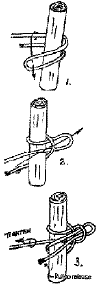
Highwayman's Hitch

Tarbuck Knot
Convenient tree, lamppost, telephone pole, etc.
Devised by mountaineer Kenneth Tarbuck
for nylon rope. The knot grips
adequately,
but under sudden stress will slide to a
limited extent thus reducing
shock.

Harvester's Hitch

Middleman's Knot

Scaffold Hitch and Spanish Windlass
(a device for applying multiple pulling power).

Alpine Butterfly (?)

Cat's Paw

Barrel Sling, Midshipman's Hitch,
and Guy Line Hitch. A Midshipman's
Hitch is used to replace a lost or
broken slider.

Man Harness Knot
Rope Work
Knots are made, not tied.
A Hitch is a method of making a rope fast to another rope or object, and is incomplete in itself. A Bend is a method of joining ropes together.
Knots, bends and hitches can be used:
- to join (reef sheetbend, fisherman's etc..).
- to make fast (clove-hitch, round tam and two half hitches, rolling hitch, fisherman's bend).
- to make fast for quick release (highwayman s and other draw hitches).
- to strengthen (sheepshank).
- to shorten (sheepshank).
- to attach (cats paw, larks-head).
- to slip (running bowline).
- to slip and grip (figure-of-eight, guy line hitch).
- to make non-slip loops (bowline in end of rope, man-harness, middleman's, alpine butterfly).
- to act as sheave (harvester's hitch).
- to act as temporary stopper to prevent rope un-laying or prevent free end from naming through block (figure-of-eight).
- to act as brake (tarbuck- a climber's knot generally used in nylon rope).
Most knots can be made "slippery" (e.g.. slip-reef) by finishing with the bight.
When teaching knots, immobilize the standing part so than it cannot be used.
Measurement of Rope
Length is measured in feet or fathoms.
The Size of a rope is the circumference in inches. Cordage under 1 inch is known as line or cord.
Lashings
To calculate the length of lashing required, take diameter of larger spar in inches and call it fathoms; thus, 6 inches diameter would require 6 fathoms of lashing, Allow more for figure-of-eight lashing.
To determine size of lashings, diameter of larger spar in feet gives diameter of lashing in inches; thus 6 inch diameter spar would require 1/2-inch diameter lashing (roughly 1 1/2 inches circumference).
"Wrap thrice, Frap twice"
Safe Working Load
Double the square of the circumference and call it cwts., viz.: a 3 inch rope would give a S.W.L. of 2 x 32 = 18 owls.
Care of Rope
Ends of all cordage should be stopped with a whipping, splice, or knot, in order of preference. Knots used only as temporary expedient. Splices limit the use of ropes as in most cases they would prevent reeving through a block. When not in use ropes are kept in a coil or hank. Always coil with the lay, i.e. a hawserlaid (right-hand laid) rope should be coiled clockwise.
Store in an even temperature. Never store a wet rope; lay it out in open coil to dry - never in hot sun.
Heavy ropes should be stored flat on a shelf; or suspended from wall hooks, Lighter cordage can be banked and stored in a sack suspended from a hook. (Beware of mildew.)
Simple Training Activities with Ropes
- Rope ladder making with marlin-spike and hitches or clove hitches.
- Rope ladder making, using tightly coiled rope for rungs.
- Putting highwayman's hitches on overhead beam from ground level.
- Setting up rope tackle (harvester's bitch) to increase pulling power, parbuckle, for rolling and raising heavy timber, Spanish windlass.
- Making tripods with Scout staffs and bowline. (see Scouting for Boys.)
- Practice catspaw, barrel hitch, scaffold hitch (to make bosun's chair etc.).
- Practice docker's splice, use for joining ropes together.
- Make toggle ropes (toggle spliced in one end, eye splice in other) and use for Patrol stunts.
- Practice line throwing, including use of lobstick
See Also:
Knots
Lashings
Spanish Windlass
Blocks, Tackles, Purchases
Dan Beard's "Knots, Bends, & Hitches"
Traditional
Training Handbook
©2003 Baden-Powell Scouts Association